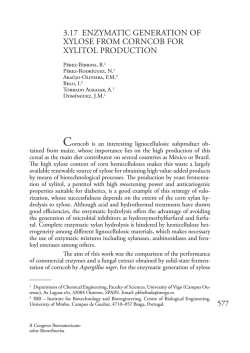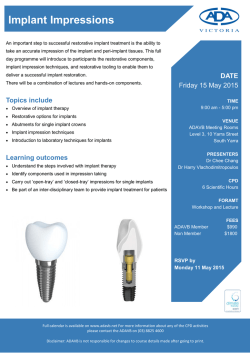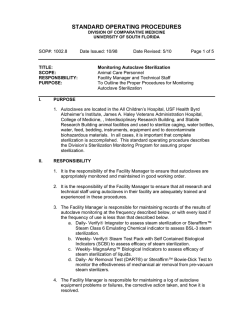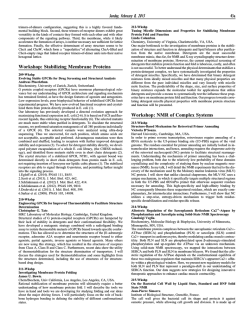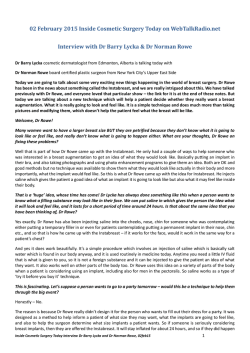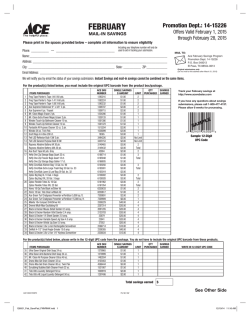
Implant Guidelines
Processing Non-sterile Synthes Implants These recommendations are for processing non-sterile Synthes implants that are sold in North America. The information provided applies to Synthes implants only. Explanted Synthes implants must never be reprocessed and should be handled according to hospital protocol upon removal. Any implant that has not been used, but has become soiled, should be handled according to hospital protocols. Refer to implant’s product insert for any specific processing, cleaning, and sterilization instructions for that implant. Cautions Limits on reprocessing Synthes does not recommend processing used implants. A used implant is an implant that has come into direct contact with a patient. Synthes implants should not be lubricated. Do not use a Synthes implant if the surface has been damaged. Do not use steel wool or abrasive cleaners on Synthes implants. In accordance with the CDC, AORN, and AAMI guidelines, Synthes does not recommend or support immediateuse steam sterilization of implants. Cleaning agents with a pH within 7-9 are recommended. Synthes implants are critical devices and must be terminally sterilized prior to use. The sterilization parameters are only valid for devices that are adequately cleaned. The following parameters are only valid for properly installed, maintained, calibrated, and compliant reprocessing equipment. Surgical patients identified as at-risk for Creutzfeldt-Jakob disease (CJD) and related infections should be treated with single-use instruments. Properly dispose of instruments used, or suspected of use, on a patient with CJD after surgery and/or follow current national recommendations. Repeated processing cycles that include ultrasonic, mechanical washing, and sterilization have minimal effects on Synthes implants. Synthes implants should be inspected for corrosion, damage such as scratches and notches, debris, discoloration, or residue. Any implant with corrosion, scratches, notches, residue, or debris should be discarded. Processing Instructions Point of Use Care Containment and Transportation Preparation for Processing Implants should remain covered until needed to avoid becoming soiled or contaminated with blood, tissue, and/or bodily fluids/matter. Only those to be implanted should be handled. Minimal handling of implants is necessary to prevent damage to the surface. Avoid cross contamination of implants with soiled instruments during transport. Synthes does not recommend processing used implants. A used implant is an implant that has come into direct contact with a patient. Equipment: various sized soft-bristled brushes, lint-free cloths, syringes, pipettes and/or water jet, neutral enzymatic cleaner or neutral detergent with a pH between 7 and 9. 1. 2. 3. 4. Processing‐ Manual Method 5. 6. 7. 8. Rinse device under running cold tap water for a minimum of two minutes. Use a soft-bristled brush to clean the device. Soak device in a neutral pH enzymatic cleaner or detergent solution for a minimum of ten minutes. Follow the enzymatic cleaner or detergent manufacturer’s instructions for use for correct exposure time, temperature, water quality, and concentration. Rinse device with cold water for a minimum of two minutes. Use a syringe, pipette, or water jet to flush lumens, channels, and other hard to reach areas. Manually clean device for a minimum of five minutes in a freshly prepared neutral pH enzymatic cleaner or detergent solution using a soft-bristled brush. Clean device under water to prevent aerosolization of contaminants. Note: freshly prepared solution is a newly-made, clean solution. Rinse device thoroughly with deionized (DI) or purified (PURW) water for a minimum of two minutes. Use a syringe, pipette, or water jet to flush lumens and channels. Visually inspect device. Perform a final rinse on device using DI or PURW water. Dry device using a clean, soft, lint-free cloth or clean compressed air. DSUS/SPN/0115/0706 January 2015 Page 1 of 4 Equipment: Ultrasonic cleaner, various sized soft-bristled brushes, lint-free cloths, syringes, pipettes and/or water jet, neutral enzymatic cleaner or neutral detergent with pH between 7 and 9. Processing‐ Mechanical Method‐ Ultrasonic Pre-clean method (Pre-clean method must be performed prior to ultrasonic mechanical method listed below.) 1. Rinse device under running cold tap water for a minimum of two minutes. Use a soft-bristled brush to clean the device. 2. Soak device in a neutral pH enzymatic cleaner or detergent solution for a minimum of ten minutes. Follow the enzymatic cleaner or detergent manufacturer’s instructions for use for correct exposure time, temperature, water quality and concentration. 3. Rinse device with cold water for a minimum of two minutes. Use a syringe, pipette, or water jet to flush lumens, channels, and other hard to reach areas. 4. Manually clean device for a minimum of five minutes in a freshly prepared neutral pH enzymatic cleaner or detergent solution using a soft-bristled brush. Clean device under water to prevent aerosolization of contaminants. Note: freshly prepared solution is a newly made, clean solution. 5. Rinse device thoroughly using cold or warm tap water for a minimum of two minutes. Use a syringe, pipette, or water jet to flush lumens and channels. 6. Visually inspect device. Ultrasonic process: (Pre-cleaning steps 1-7 should occur prior to this step.) 7. Prepare a fresh detergent solution using a neutral pH enzymatic cleaner or detergent. Follow the enzymatic cleaner or detergent manufacturer’s instructions for use for correct exposure time, temperature, water quality, and concentration. Note: freshly prepared solution is a newly made, clean solution. 8. Clean Synthes device ultrasonically for a minimum of 15 minutes. 9. Rinse device thoroughly with deionized (DI) or purified (PURW) water for a minimum of two minutes. Use a syringe, pipette, or water jet to flush lumens and channels. 10. Visually inspect device. 11. Perform a final rinse on device using DI or PURW water for a minimum of 15 seconds. 12. Dry device using a clean soft, lint-free cloth or clean compressed air. Equipment: Ultrasonic cleaner, washer/disinfector, various sized soft-bristled brushes, lint-free cloths, syringes, pipettes, and/or water jet, neutral enzymatic cleaner or neutral detergent with a pH between 7 and 9. ProcessingMechanical MethodMechanical Washer Pre-clean method (Pre-clean method must be performed prior to mechanical washer method listed below.) 1. Rinse device under running cold tap water for a minimum of one minute. 2. Manually clean device for a minimum of two minutes in a freshly prepared neutral pH enzymatic or detergent solution using a soft-bristled brush. Follow the enzymatic cleaner or detergent manufacturer’s instructions for the correct dilution, temperature, water quality, and exposure time. Clean device under water to prevent aerosolization of contaminants. Note: freshly prepared solution is a newly made, clean solution. 3. Rinse device using cold to lukewarm running tap water for a minimum of one minute. Use a syringe, pipette, or water jet to flush lumens and channels. 4. Prepare a fresh detergent solution using a neutral pH enzymatic cleaner or detergent. Follow the enzymatic cleaner or detergent manufacturer’s instructions for the correct dilution, temperature, water quality, and exposure time. Note: freshly prepared solution is a newly made, clean solution. 5. Clean Synthes devices ultrasonically for a minimum of 15 minutes. 6. Rinse device using DI or PURW water for a minimum of two minutes. Use a syringe, pipette, or water jet to flush lumens and channels. DI or PURW water must be used for final rinse. 7. Visually inspect device. Mechanical Washer process: (Pre-cleaning steps 1-8 should occur prior to this step.) 8. Process device using the following cycle parameters: Cycle Pre-wash Minimum Time (minutes) 2 Minimum Temperature/Water Cold tap water Wash I 2 Cold to warm tap water Wash II Rinse Dry 5 2 40 Warm tap water (>40°C) Warm DI or PURW (>40°C) 90°C Type of Detergent N/A Neutral enzymatic pH between 7 and 9 Detergent with pH between 7 and 9 N/A N/A DSUS/SPN/0115/0706 January 2015 Page 2 of 4 Thermal disinfection Inspection Packaging For automated cleaning, thermal disinfect at 93°C for minimum of 2 minutes and 30 seconds. Synthes implants should be inspected after processing, prior to sterilization. Any implant with corrosion, discoloration, scratches, flaws, residue or debris should be discarded. Only legally marketed, FDA-cleared sterilization barriers (e.g. wraps, pouches, or containers) should be used by the end-user for packaging terminally sterilized devices. Rigid Sterilization Container Use Instructions and Considerations In order to ensure proper sterilization of Synthes’ devices when using a rigid sterilization container, the following must be taken into consideration: o Only FDA-cleared rigid sterilization containers may be used with Synthes’ devices and loaded graphic cases (a graphic case with all or part of its assigned contents). o The rigid sterilization container manufacturer’s instructions for use are to be followed. If questions arise regarding the use of the rigid sterilization container, Synthes recommends contacting the manufacturer of that specific container for guidance. o The options in using rigid sterilization containers with Synthes’ devices and loaded graphic cases are as follows: No more than one (1) fully loaded graphic case can be placed into a rigid sterilization container. Instrument trays from no more than one (1) loaded graphic case can be placed in the rigid sterilization container. Stand-alone modules/racks or single devices must be placed, without stacking, in a container basket to ensure optimal ventilation. o Rigid sterilization container must have a maximum volume to vent ratio of no greater than 127 in3/in2. For any questions related to the volume to vent ratio, please contact the container manufacturer. o Only rigid sterilization containers approved for pre-vacuum steam sterilization can be used with Synthes’ devices and loaded graphic cases following the sterilization parameters provided by Synthes. o End-users should follow ANSI/AAMI ST79 for additional information concerning the use of rigid sterilization containers. The following are the recommendations for the sterilization of Synthes’ implants: Sterilization Cycle Type Minimum Sterilization Exposure Time (minutes) Minimum Sterilization Exposure Temperature Minimum Dry Time* Prevacuum 4 132°C (270°F) 20 minutes *When applying dry times to Synthes cases and their accessories, dry times outside the standard healthcare prevacuum parameters may be required. This is especially important for polymer-based (plastic) cases/trays used in conjunction with heavy duty nonwoven sterilization wraps. The current recommended dry times for Synthes cases can range from a standard 20 minutes to an extended time of 60 minutes. The dry time is most often influenced by the presence of polymer based (plastic) materials; therefore, changes such as elimination of silicone mats and/or change in sterile barrier system (e.g. heavy grade to light grade wrap or the use of rigid sterilization containers) can reduce the necessary dry time. Dry times may be highly variable due to differences in packaging materials (e.g. nonwoven wraps), environmental conditions, steam quality, implant materials, total mass, sterilizer performance, and varying cool down time. The user should employ verifiable methods (e.g. visual inspections) to confirm adequate drying. The autoclave manufacturer’s operating instructions and recommended guidelines for maximum sterilization load should be followed. The autoclave must be properly installed, maintained, and calibrated. Only legally marketed, FDA-cleared sterilization barriers (e.g. wraps, pouches, or containers) should be used by the end-user for packaging terminally sterilized devices. For product sold sterile, refer to device specific insert for limitations regarding resterilization. DSUS/SPN/0115/0706 January 2015 Page 3 of 4 Additional Information Manufacturer Contact Sterile product that has exceeded the labeled expiration date and has intact and undamaged original packaging may be sterilized using the above sterilization parameters unless product is coated, i.e HA, plasma, etc. or resterilization is not permitted. Refer to device specific insert for limitations regarding resterilization. Cleaning Agent Information: Synthes used the following cleaning agents during validation of these reprocessing recommendations. These cleaning agents are not listed in preference to other available cleaning agents which may perform satisfactorily- neutral pH enzymatic detergents (e.g. Prolystica 2X Concentrate Enzymatic Cleaner, Enzol, Endozime, and Neodisher Medizym) and neutral pH detergents (e.g. Prolystica 2X Neutral Detergent). The cleaning and sterilization information is provided in accordance with ANSI/AAMI ST81, ISO 17664, AAMI TIR 12, ANSI/AAMI/ISO 17665-1, ANSI/AAMI ST79, and AAMI ST77. The recommendations provided above have been validated by the medical device manufacturer as being capable of preparing a non-sterile Synthes medical implant. It remains the responsibility of the processor to ensure that the processing is actually performed, using equipment, materials, and personnel in the reprocessing facility, and achieves the desired result. This requires validation and routine monitoring of the process. Likewise, any deviation by the processor from the recommendations provided should be properly evaluated for effectiveness and potential adverse consequences. All users should be qualified personnel with documented expertise, competency, and training. Users should be trained on hospital policies and procedures along with current applicable guidelines and standards. Users should don appropriate personal protective equipment (PPE) when processing implants in accordance with the Department of Environment and Occupational Health and Safety’s (OSHA) bloodborne pathogen guidelines. For further information, contact DePuy Synthes Customer Service Department at 1.800.523.0322. Manufactured by (United States): Synthes USA Products, LLC 1302 Wrights Lane East West Chester, PA 19380 Telephone: (610) 719-5000 To order: (800) 523-0322 Fax: (610) 251-9056 Legal manufacturer (Canada): Synthes (Canada) Ltd. 2566 Meadowpine Blvd. Mississauga, Ontario L5N 6P9 Telephone: (905) 567-0440 To order: (800) 668-1119 Fax: (905) 567-3185 DSUS/SPN/0115/0706 January 2015 Page 4 of 4
© Copyright 2026
